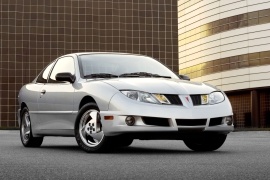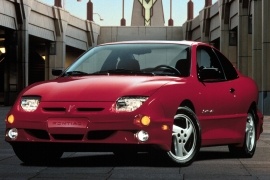PONTIAC Sunfire Coupe Models/Series Timeline, Specifications & Photos
First production year: 2000
Engines: Gasoline
Body style: Coupé (two-door)
Built to compete against the light-coupe import market, the Sunfire arrived in 1995 as a replacement for the Pontiac Sunbird. In 2002 it went through a major facelift.
The budget sport-coupe market in the U.S. was dominated by the Honda Civic coupe and Toyota Celica. Their high-revving engines, but with low torque, increased their market share. The GM launched the Sunfire as a countermeasure for them, with bigger engines.
The 2002 model-year featured a completely new front end design. The wider, sleek-looking, headlights, and the specific Pontiac grille were the most important visible upgrades over the 1995 model. A more aggressive bumper with three air-intakes and the fog-lights on the outer side, made the car look like it went through a custom-car shop. The Sunfire was available as a sedan, coupe, and convertible. The coupe was the sportiest looking one and it featured raised beltline on the quarter panels. A small wing was installed at the base of the rear windscreen. Three-spoke specific light-alloy wheels were installed.
Inside, a four-spoke steering wheel was installed. The instrument cluster was rounded on a bulge in the front of the driver and featured four analog dials. On the center stack, there was a low-spec stereo and the controls for the air-conditioning unit. The front bucket-seats were built to offer good stability during high-speed cornering, even though the car was not as fast as it looked.
From 2003 to 2005, when the car was retired, the Sunfire was offered with only one engine: a 2.2-liter that offered 140 hp, which was less than what the import-cars offered.
Pontiac introduced a facelifted version for its small-sized Sunfire lineup in 2000, continuing its struggle against imported sport compact vehicles.
While Pontiac was known for some sporty models, such as the Firebird or the GTO, the Sunfire was yet to make a name for itself. After it replaced the Sunbird with the Sunfire, the small-sized coupe also adopted a sleeker look, and the refreshed version went even further, adding some cues from its bigger brothers. Unfortunately for Pontiac, its main competitor was its sibling, the Chevrolet Cavalier coupe, which was sold in five-time higher volumes than the Sunfire.
The car's front fascia received a lower apron that resembled the one installed on the Firebird, with a V-shaped lower section split in three areas by oblique slats. Depending on the version, the small coupe featured two air intakes in the bumper's upper section that helped cool the engine. Still, its headlights were not exactly up to date, sporting a rectangular shape, and leaned on the hood. From its profile, the cab-rearward profile was ended by a short, sloped-down deck. A wing was available as an option.
Inside, the affordable coupe was fitted with cheap plastic materials on the dashboard, but the overall design was good. The tilt-forward front bucket seats were bolstered for some side support, and the instrument cluster was fitted with easy-to-read dials for the speedometer, tachometer, fuel level, and coolant temperature. In the back, the automaker offered room for two, but with minimal headroom and legroom.
Under the hood, Pontiac installed a choice of engines carried over from GM's parts bin. The five-speed manual was standard across the range, while a four-speed automatic was available at extra cost.

